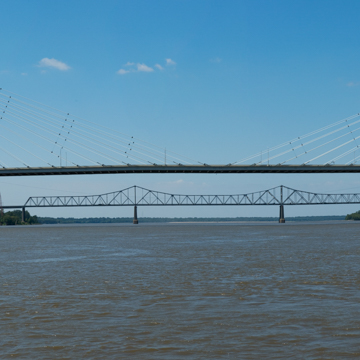Until 1940, when a bridge was constructed across the Mississippi River, ferries and steamboats facilitated communication between the southeastern corner of Arkansas and Mississippi. Also designed by the Kansas City firm HNTB, the first bridge was a steel through truss structure. Driving on the bridge was perilous, for it was only two lanes wide, with no shoulders, and because it spanned a large bend in the Mississippi, it was repeatedly hit by barges as they attempted to make the river’s sharp curve. This new bridge with its 2.5-mile span was the fourth longest cable-stayed bridge in North America when it opened. The bridge has a four-lane deck, and with approaches and new roadway it totals 3.84 miles in length. Its cable-stayed design is the optimum bridge type for a span of this length for wind, vibration, and seismic activity. The two H-shaped concrete towers that carry the prestressed steel cables soar 425 feet above the Mississippi River, and the concrete piers are anchored 120 feet into the riverbed. While the combination of piers, cables, and span of a cable-stayed bridge are inherently elegant and visually dramatic, this white beauty also stands out in its lush green surroundings as a true landmark.
You are here
Greenville Bridge
2001–2010, Howard Needles Tammen and Bergendoff (HNTB). U.S. 82 spanning the Mississippi River to Greenville, Mississippi, approximately 9 miles southeast of Lake Village
If SAH Archipedia has been useful to you, please consider supporting it.
SAH Archipedia tells the story of the United States through its buildings, landscapes, and cities. This freely available resource empowers the public with authoritative knowledge that deepens their understanding and appreciation of the built environment. But the Society of Architectural Historians, which created SAH Archipedia with University of Virginia Press, needs your support to maintain the high-caliber research, writing, photography, cartography, editing, design, and programming that make SAH Archipedia a trusted online resource available to all who value the history of place, heritage tourism, and learning.











